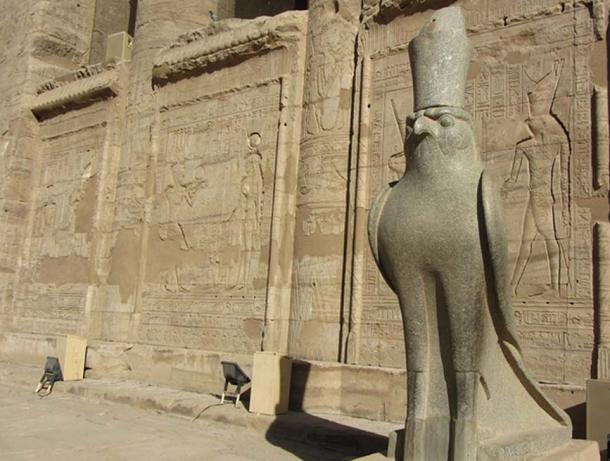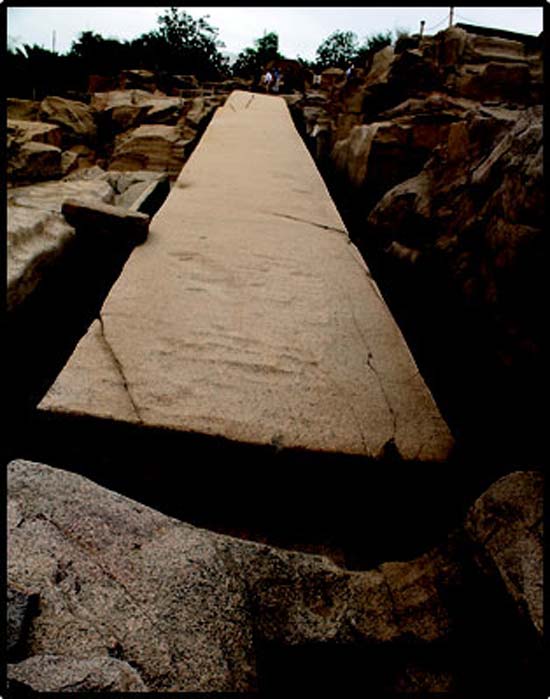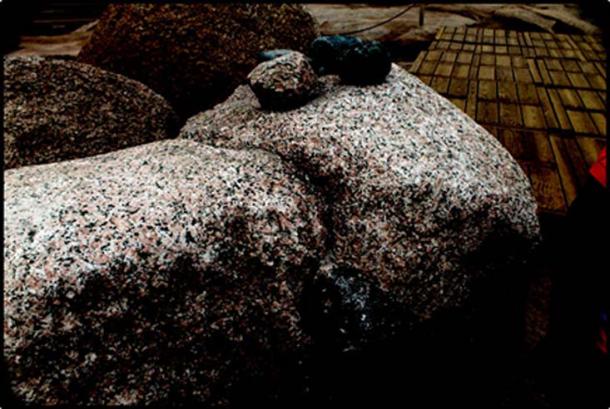Most people know of the great construction achievements of the dynastic "Big Stone gap" Egyptians such as the pyramids and temples of the Giza Plateau area as well as the Sphinx. Many books and videos show depictions of vast work forces hewing blocks of stone "Big Store gap" in the hot desert sun and carefully setting them into place. However, some of these amazing works could simply not have been made by these people during the time frame that we call dynastic Egypt.
Up until the 7th century BC there was very little iron present in Egypt, as this material only became commonly used once the Assyrians invaded at that time; in fact, the ancient Egyptians regarded iron as an impure metal associated with Seth, the spirit of evil who according to Egyptian tradition governed the central deserts of Africa. A few examples of meteoric iron have been found which predate the Assyrians, but this consists largely of small ornamental beads.

Stone sculpture of Horus in Egypt. Source: Public Domain
The very basic problem that arises is that we find at many of the ancient sites in Egypt finely crafted works in basalt, granite, quartzite and diorite which are very hard stones that can't be shaped efficiently even by hardened iron tools. For most of the history of Egypt,"Big Stone gap" the tools used to shape stone consisted of hardened bronze, which is much softer than iron. In this article, we will see examples of ancient hard stone workmanship which simply could not have been created during the dynastic Egyptian time frame of about 2500 to 1500 BC, when most academics believe they were made. Only a few examples will be discussed, and far more can be seen and read about in my Lost Ancient Technology Of Egypt book.
A Famous Unfinished Obelisk
We start in Aswan, which is close to the border of Sudan, and it is here that we find the famous unfinished obelisk, and another smaller one, still attached to the granite bedrock.

The large unfinished obelisk in the Aswan quarry. (Author provided)
Archaeologists claim the female ruler known as Hatshepsut, who came to the throne in 1478 BC sanctioned the construction of the bigger of the two. It is nearly one third larger than any ancient Egyptian obelisk ever erected. If finished, it would have measured around 42 m (approximately 137 feet) and would have weighed nearly 1,200 tons. The greatest questions that arise are: what tools could have been used to shape this massive stone monument, and how were the Egyptians planning on raising it out of the pit in which it sits, taking into account its immense size. To the former, most "Big Stone gap" Egyptologists believe that round and hand-held stone dolerite pounders were the main tools being used.In basic terms, any tool should have a greater hardness than the material being cut or shaped. The pink granite of which the unfinished obelisk is composed has a Mohs hardness that sits between the scale of 6 and 7, (the maximum being diamond at 10) and thus is more or less the same hardness as dolerite, making the latter a poor material for shaping the former. And bronze, the other tool substance known to and used by the ancient "Big Store gap" Egyptians is much softer, being on average 3.5 on the Mohs scale.

Dolorite pounders on top of a piece of pink Aswan granite. (Author provided)
Other problems encountered at the unfinished obelisk is that there is very little room inside the trench to be able to create a hard blow, and such repeated efforts could also break the dolerite tool. According to engineer and expert machinist Christopher Dunn, author of Lost latest Technologies of Ancient "Big Stone gap" Egypt: Advanced Engineering in the Temples of the Pharaohs:
'The unfinished obelisk offers compelling indirect evidence regarding the level of technology its creators had reached – not so much by indicating clearly what methods were used, but by the overpowering indications of what methods could not have been used.'



No comments:
Post a Comment